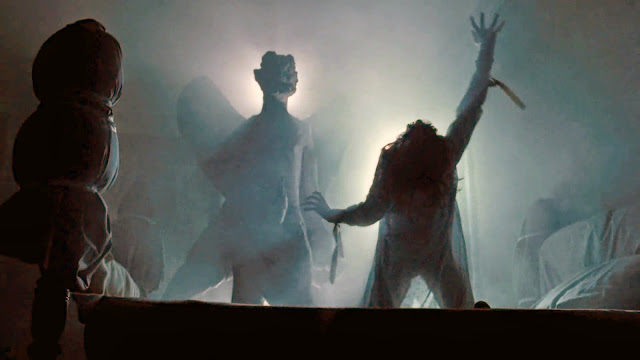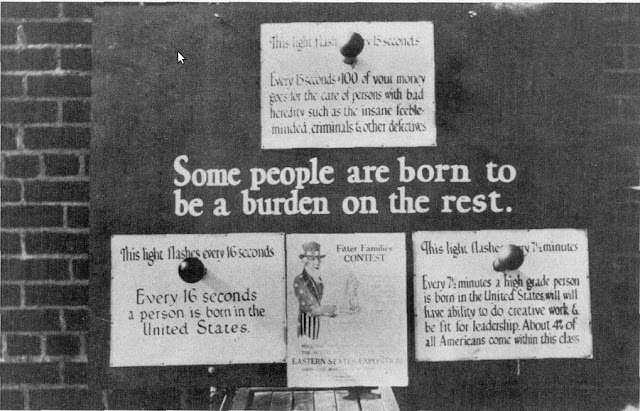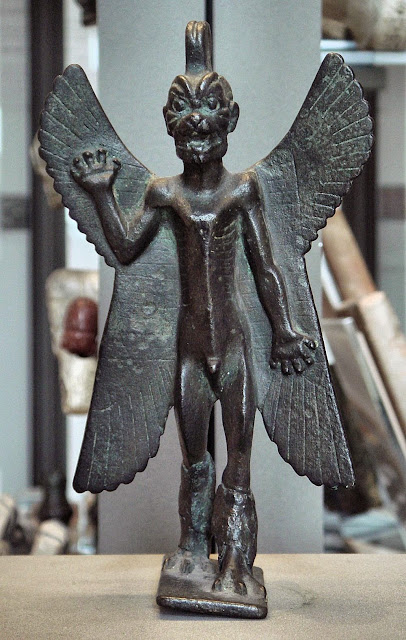“It is not as a woman descended from noble ancestry, but as one of the people that I am avenging lost freedom, my scourged body, the outraged chastity of my daughters. Roman lust has gone so far that not our very persons, nor even age or virginity are left unpolluted.”
“But heaven is on the side of the righteous vengeance; a legion which dared to fight has perished; the rest are hiding themselves in their camp, or are thinking anxiously of flight. They will not sustain even the din and the shout of so many thousands, much less our charge and our blows.
“If you weigh well the strength of the armies, and the causes of the war, you will see that in this battle you must conquer or die.
This is a woman’s resolve.
As for the men, they may live and be slaves!”
(Also: Andrasta, Adraste and Andred)
(Romano-Celtic; British; Breton; Anglo-Celtic; Continental Europe)
Some of her correspondences are:
Animal: Raven (occasionally, the Hare)
Astral Body: Moon (probably waxing)
Tidbit: Some Celtic coins are thought to show images of Andraste.
Andraste is a warrior goddess, the goddess of victory, of ravens and of battles, similar in many ways to the Irish war goddess, Morrigan. Besides "the invincible one," her name is also known to mean "she who has not fallen". It is told that her presence was evoked on the eve of battle to curry favor, and as a goddess of divination, she was probably called upon to divine the outcome of battles and war.
She was venerated in woodland groves throughout Southern Britain and there is told of a sacred grove dedicated to Andraste somewhere in Epping Forest. She is known symbolized by the hare, partly due to Boudicca’s veneration of her, and due to some misinterpretations of lore.
As Andred (her Roman name is Andraste – Macha notes: how cunning she’d call the goddess by her Roman name while engaged in battle with the Romans!), she was a lunar mother-goddess figure associated with fertility and love. In her dark aspect however, she was associated primarily with warfare and specifically with victory. She is sometimes compared to the goddess Andarte, a deity worshipped by the Vocontii of Gaul.
A warrior goddess or goddess of war, Andraste was invoked on the eve of battle to curry favor, and ritual sacrifices may have been made to her.
In Celtic Britain, in 61 CE, the widow of King Praesutagus of Iceni, Queen Boudicca (Latin: Boadicea), was the leader of a rebellion against the Roman occupation. She allegedly sacrificed captive Roman women to this goddess. According to Dio Cassius, Andraste was a Celtic goddess thanked by Boudicca while fighting against the Roman occupation of Britain, and she is mentioned only once. She may be the same as Andante, mentioned later by the same source, and described as 'their name for Victory', i.e. the Goddess Victoria. Boudicca released a hare as part of the rite of appeasement to Andraste, and she devoted the spoils of her battles to the goddess as well.
There is a misconception concerning Andraste. Many neo-pagan sources describe the hare as sacred to Andraste. This seems to derive from a misreading of the passage in Dio Cassius, in which Boudicca releases a hare from the folds of her clothing:
"‘Let us, therefore, go against (the Romans), trusting boldly to good fortune. Let us show them that they are hares and foxes trying to rule over dogs and wolves.’
When she had finished speaking, she employed a species of divination, letting a hare escape from the fold of her dress and since it ran on what they considered the auspicious (lucky) side, the whole multitude shouted with pleasure, and Buduica, raising her hand toward heaven, said:
‘I thank thee, Andraste, and call upon thee as woman speaking to woman...’”
The hare's release is described as a technique of divination, with an augury (omen) drawn from the direction in which it runs. This appears to be similar to Roman methods of divination which ascribe meaning to the directions in which birds fly, with the left side being favorable and the right side unfavorable.
Taking an omen at this point before a battle is a means of testing the 'good fortune' of which Boudicca speaks, with no suggestion that the hare is sacred to Andraste. More importantly, the unflattering comparison of the Romans with 'hares and foxes' is not consistent with the reverence one would expect if the hare were a symbol of the Goddess. Boudicca is evidently giving thanks to Andraste for the omen of victory and not addressing the hare as Andraste or a symbol of Andraste per se.
Andraste may be considered as the patron Goddess of the Iceni tribe due to Boudicca’s reverence of her.
In "The White Goddess," Robert Graves speaks of a "taboo" in Britain against hunting hares for fear that killing one might afflict the hunter with cowardice. He considers the likelihood that Boudicca in fact released the animal hoping that the Romans might strike at it, and loose their courage.
The army of Queen Boudicca sacked the cities of Camulodunum (Clochester), Londinium (London) and Verlanium (St. Albans), and it appears that the conquering of London was exceptionally savage. According to Roman historian Tacitus, the Roman women were rounded up, taken to a grove that was dedicated to the worship of the Celtic war goddess, Andraste, where they were murdered, had their breast cut off and stuffed into their mouths; then were impaled with large skewers. This sacred grove was known to the Britons as Andraste's Grove and is thought to have been somewhere in Epping Forest.
Incidentally, there is also a possible link from Queen Boudicca to the Celtic goddess, Boudiga (Welsh root, 'budd'), whose name means "victory." It is possible that the name is a religious title, perhaps given to Boudicca during the early part of the rebellion.
It is therefore likely that Boudicca occupied a dual position both as tribal leader and as the manifestation of a Druidic or Celtic Goddess. There is the mystery of Boudicca’s name; Boudicca means ‘victory’ as well. She has also been identified with Brigantia, the war goddess of the Brigantes (the Romans called Brigantia, ‘Victory,’ and even by 200AD altars were still being erected to her). Brigantia/Brigantes (& perhaps Queen Boudicca herself) is linked with Morrigan, known as the Great Queen in Ireland. She is also associated with the triple war goddess whose three persons are Nemain (Frenzy), Badb Catha (Battle Raven) and Macha (Crow) whose sacred birds fed upon the stake impaled heads of those slaughtered in battle.
Boudicca, it is said, sacrificed those she defeated in battle to Andrasta, she took no captives; therefore, it could possibly be deduced that Boudicca was not her personal name, but perhaps an official or religious title which would mean that from the point of view of her followers that she was the personification of a goddess.
This would help to explain the fanaticism of her followers who were drawn to her from a variety of tribes and their unusual willingness to unite so completely, and to follow the leadership of a woman in battle. Tacitus’ observation that Boudicca released a hare between the two armies before the battle, suggests that this is indication of a priestess seeking augury. Further that the mutilation of the dead, indicating that many were not just killed but sacrificed to the Celtic Goddess Andrasta, indicates Boudicca's status as a priestess of that goddess.
Boudicca gave a speech before her final battle:
"It is not as a woman descended from noble ancestry, but as one of the people that I am avenging lost freedom, my scourged body, the outraged chastity of my daughters. Roman lust has gone so far that not our very persons, nor even age or virginity is left unpolluted.
But heaven is on the side of the righteous vengeance; a legion which dared to fight has perished; the rest are hiding themselves in their camp, or are thinking anxiously of flight. They will not sustain even the din and the shout of so many thousands, much less our charge and our blows.
If you weigh well the strength of the armies, and the causes of the war, you will see that in this battle you must conquer or die. This is a woman's resolve. As for the men, they may live and be slaves!"
So, we have alluring glimpses of a Goddess to whom very little is known. Andraste, warrior Goddess of the Iceni tribe, who accepted sacrifices of hares, and perhaps humans, represented the darkest, and perhaps the most needed, aspects of war-craft to be called upon in times of dire emergency and propitiated with the sacrifice of blood which is considered the most potent magic of all.
Here in her darkest aspect, she would be seen as the Crone, the Dark Mother, represented by the waning Moon, the Cutter of the Threads, the one to whom all return. It is not so strange since death is so much a part of warfare.
Her dark side is tempered by her aspect as Andred; here she is a lunar mother-goddess figure associated with fertility and love, the creator and bringer of life. It’s also possible that another of her aspects, her maiden or youthful side (whose name we don’t know) was also worshipped as a goddess of the hunt. As a lunar Goddess, the Maiden, Mother, Crone triplicity would most certainly have been venerated.
Andraste does not appear in Celtic Gaul, though a deity named Andraste is mentioned by the Roman writer, Dio Cassius. Adrasta (and Andred), however, seems to be related to Andarta in some way. Andarta is a probable fertility goddess revered by the Gallic Celtic tribe, Vocontii, as their patron. Her name seems to have derived from either “artos” meaning bear, or “ar” meaning ploughed land.
Incidentally, another goddess, Andrastae, a Hellenized Phrygian mountain goddess of southwestern Turkey, is believed to be a derivative of an Anatolian mountain deity who is known from inscriptions in Greece from Circa 400 BC as a deity who defends the righteous; however, it is uncertain as to whether or not Andrastae is a derivative of the Andraste entreated by Boudicca.
In closing, there are very few documented sure references to or about Andrasta and her aspects and counterparts. The little information there is has been recounted and retold over again. Her true origins and purpose are still a mystery, and it is insinuated that this goddess’ myth may be so ancient that we may not know her true story or myth. All we have are spotted inklings of her and the story of her insinuated by Queen Boudicca’s tale.
In magick and meditation, you can work with Andraste to overcome enemies, but be very mindful of how you approach her and work with her. Do not approach Andraste (or any war deity or warrior deity) while you are confused, upset, sad, hurt or angry as these feelings may fuel your work as well as hers! Be very thorough in voicing what it is you want from her and tell her exactly what outcome you want. Even if you invite her only to be present during your ritual and are not asking for her aid, still be careful; leave no room for this goddess to misunderstand you. Also, be sure to thank her lavishly and wholeheartedly.
Since we cannot be sure what types of veneration to give Andraste, the war goddess, Macha’s recommendation is to try hearty things such as mead (or beer) and fine cuts of meat (hare or rabbit, venison, beef, pork, buffalo or ox perhaps) for gifts and offerings.
The best advice is, not to invoke a goddess like Andraste without first studying her and meditating with her and establishing a positive relationship and open lines of clear communication with her.
**
Sources:
Books:
-A History of Pagan Europe by Prudence Jones & Nigel Pennick
-Celtic Myth & Magick by Edain McCoy
-Celtic Gods and Goddesses by R.J. Stewart
-Encyclopedia of Gods by Michael Jordan
-The White Goddess by Robert Graves
Website sources:
Encyclopedia Mythica
Boudicca's Army Attacks
Led by Boudicca, about 100,000 British attacked Camulodunum (now Colchester), where the Roans had their main center of rule. With Suetonius and most of the Roman forces away, Camulodunum was not well-defended, and the Romans were drive out. he Procurator Decianus was forced to flee. Boudicca's army burned Camulodunum to the ground; only the Roman templewas left.
Immediately Boudicca's army turned to the largest city in the British Isles, Londinium (London). Suetonius strategically abandoned the city, and Boudicca's army burned Londinium and massacred the 25,000 inhabitants who had not fled. Archaeological evidence of a layer of burned ash shows the extent of the destruction.
Next, Boudicca and her army marched on Verulamium (St. Albans), a city largely populated by Britons who had cooperated with the Romans and who were killed as the city was destroyed.
Changing Fortunes
Boudicca's army had counted on seizing Roman food stores when the tribes abandoned their own fields to wage rebellion, but Suetonius had strategically seen to the burning of the Roman stores. Famine thus struck the victorious army, weakening them.
Boudicca fought one more battle, though its precise location is not sure. Boudicca's army attacked uphill, and, exhausted, hungry, was easy for the Romans to rout. Roman troops of 1,200 defeated Boudicca's army of 100,000, killing 80,000 to their own loss of 400.
What happened to Boudicca is uncertain. It is said she returned to her home territory and took poison to avoid Roman capture.
A result of the rebellion was that the Romans strengthened their military presence in Britain and also lessened the oppressiveness of their rule.
Boudicca's story was nearly forgotten until Tacitus' work, Annals, was rediscovered in 1360. Her story became popular during the reign of another English queen who headed an army against foreign invasion, Queen Elizabeth I.














































